Ebola Diaries
In the wake of the Ebola epidemic in West Africa, attention is focused on how to strengthen health systems in Guinea, Liberia, and Sierra Leone so that another such outbreak can be predicted and, perhaps, prevented.
MEASURE Evaluation has several staff members embedded in the ministries of health (MOH) in Liberia and Guinea helping with this effort. I’m Scott McKeown and I’m one of them.
This is the story of what it’s like to be embedded, of the work we are doing, of what it can mean for Guinea and the region, and for what it can teach us in service of health systems globally. Every few days, I’ll update this blog space with information about life and work in Guinea.
Post #1: Becoming Embedded
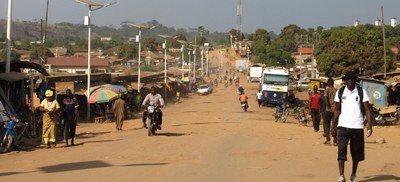 The outbreak of the Ebola virus in West Africa in 2014 revealed weaknesses in health information systems (HIS) that otherwise might have provided an early alert to health officials of the emerging epidemic. The first need, of course, was to treat sick people and stop the spread of the disease. Now, in its wake, attention is focused on how to strengthen those health systems in Guinea, Liberia, and Sierra Leone so that another such outbreak can be predicted and, perhaps, prevented.
The outbreak of the Ebola virus in West Africa in 2014 revealed weaknesses in health information systems (HIS) that otherwise might have provided an early alert to health officials of the emerging epidemic. The first need, of course, was to treat sick people and stop the spread of the disease. Now, in its wake, attention is focused on how to strengthen those health systems in Guinea, Liberia, and Sierra Leone so that another such outbreak can be predicted and, perhaps, prevented.
MEASURE Evaluation has several staff members embedded in the ministries of health (MOH) in Liberia and Guinea helping with this effort. I’m Scott McKeown and I’m one of them.
I work with MEASURE Evaluation as a Team Lead for one of its partner organizations (Management Sciences for Health). MEASURE Evaluation is USAID’s flagship project to support monitoring and evaluation of health systems and to strengthen health information systems in developing countries. That’s, in a nutshell, why I’m here in Conakry, Guinea, for the next three months. Guinea’s health system was caught largely unaware during the Ebola epidemic. We’re trying to strengthen the system so that doesn’t happen again.
This is the story of what it’s like to be embedded, of the work we are doing, of what it can mean for Guinea and the region, and for what it can teach us in service of health systems globally.
Conakry, the capital city of Guinea, is slowly moving back toward “normal,” although there are still a few cases of Ebola being reported each month. Walking on the streets of the capital, you notice almost immediately how Ebola has changed everyday life. Almost every business and official building has a handwashing station at the main door. These range from the very sophisticated, with sanitizer, soap, water, towels, and an attendant to enforce use, to more basic, which have water but little else. A few building entrances also have entry control posts, where guards digitally read your forehead temperature with a hand-held sensor. If the reading is 38 degrees centigrade or above, you are asked to step aside and medical authorities are called.
Many people no longer shake hands upon meeting. Instead, they “fist bump.” Not shaking hands was a public health education message to limit the spread of Ebola, widely observed at first, but now diminishing as the anxiety over the disease is also diminishing.
Conakry is bustling with global health organizations, largely coordinated by UN agencies such as the World Health Organization (WHO), along with support from many countries, especially France and the United States. U.S. government efforts are multiple and broad and include the U.S. Agency for International Development (USAID), the Centers for Disease Control and Prevention (CDC), the Office of Foreign Disaster Assistance (OFDA), and others.
Navigating road traffic when getting to and from work is in itself a major challenge. Conakry is basically a 22-mile peninsula, with the city center and many commercial and most government offices at the narrow, seaward end, and the more residential areas fanning out as you go inland. The streets downtown are narrow, penned in by buildings, and clogged. The majority of people live up the peninsula. Estimates vary, but Conakry is thought to be home to roughly two million of Guinea’s 12 million inhabitants. During the week, depending on the time of day and a number of other unpredictable factors such as construction, one-way traffic routing, and official motorcades, it can take an hour or more to go a few miles. Many who work downtown must leave their homes at 5 a.m. or 6 a.m. in order to arrive at work by 9 a.m.
Which is why I’m staying in a hotel downtown, foregoing some modern hotel amenities in favor of a short walk to work. So, that’s the setting for the work ahead.
Post #2: Embedded: Connected and Not Connected
 The Ministry of Health is downtown, whereas many partner agencies are located further up the peninsula. This has a large implication on work hours, the predictability of people being in their offices, where one can or should hold meetings, and how often one can meet.
The Ministry of Health is downtown, whereas many partner agencies are located further up the peninsula. This has a large implication on work hours, the predictability of people being in their offices, where one can or should hold meetings, and how often one can meet.
There are a lot of people to connect with, each of them a “stakeholder” in some form or fashion in this effort to help Guinea. A non-exhaustive list, in no particular order of relevance/priority to the U.S. government (USG) and the MEASURE Evaluation mandate, are: USAID and funded partners (RTI International, Jhpiego, Catholic Relief Services, Management Sciences for Health, Helen Keller International, IntraHealth), other USG partners (e.g., CDC), UN agencies (WHO, Office for the Coordination of Humanitarian Affairs, the High Commissioner for Refugees, World Food Program), the Global Fund, the World Bank, the French Embassy/Development Agency (France Expertise, AFD), the Gesellschaft fuer Internationale Zusammenarbeit (GIZ), Médicins sans Frontiѐres, and the Japanese Embassy/JICA).
As I’m living downtown, my commute to the Ministry of Health is stress-free, but the work environment is quite “foreign” to the digital office environment at home. My embedded colleague, Richard Gakuba, and I first pass by the Director’s Office, to greet him and to let him know we’re there in case there’s anything he wants to see us for. There is no computer or server in the Ministry of Health (MOH), no connected network, and therefore no Outlook calendar or any easy way of knowing peoples’ schedules. The most common practice is just to ask people whether or not they know where the person you are looking for can be found and when that person might be back.
At times you are reminded of the way work used to happen before computers and mobile devices. But it’s a conundrum in the Guinea context. The necessary work to strengthen health systems requires the ability to gather quality data and to enable a high degree of coordination between health officials and partners working across the country.
While development assistance has always relied on timely, quality information, the need is even more acute in Guinea and the effort has been complicated by at least two main factors: 1) Early in the Ebola epidemic, it was decided that in order to coordinate the country response at the highest levels of government, an Ebola response group was created operating out of the President’s Office rather than the Ministry of Health, which led to 2) an unanticipated consequence of isolating the MOH from involvement in many of the health activities and from the incoming health resources (read: money) during the past year.
Now that the focus has shifted towards institutional strengthening and maintenance of the health information system, there is a desire to move some responsibilities and activities back to the MOH. Hence, there is a need for precise and ongoing communications, but without the benefit of a connected technology infrastructure…, well, you can see the challenge. Despite this, progress is being made. More about that next time.
Post #3: A Day at the Office
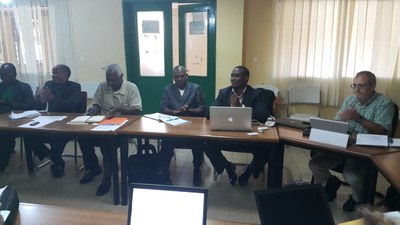 After a very busy couple of weeks meeting folks, getting the lay of the land, and establishing the necessary relationships with people we’ll be working with, we submitted a work plan for the three-month embedded period. It’s ambitious, but there is enthusiasm for having us here and the work to be done, so we are hopeful.
After a very busy couple of weeks meeting folks, getting the lay of the land, and establishing the necessary relationships with people we’ll be working with, we submitted a work plan for the three-month embedded period. It’s ambitious, but there is enthusiasm for having us here and the work to be done, so we are hopeful.
The World Health Organization (WHO) and its partners are focused on “Getting to Zero” cases of Ebola. Once Guinea reaches 42 days with no new Ebola cases reported, the country will be declared Ebola-free and WHO and partners will continue surveillance for another three months, followed by a gradual turnover of monitoring and reporting to the country systems. It is thought that, at that point, whatever general systems strengthening efforts have been going on will be capable of monitoring and provide early detection, reporting, and response to public health epidemics in the future, Ebola or otherwise. This, really, is where MEASURE Evaluation comes in.
Our mandate is to:
- Develop and initiate implementation of the health information system (HIS) strategy, including a costed operational plan for country-led HIS development, and institutional capacity strengthening in Guinea
- Renew advocacy and clarify the advantages to Guinea of adopting DHIS 2 as the HIS platform
- Enhance MOH capacity to use data for decision making
Richard Gakuba is the IT person and I’m the organization development person. We’re working specifically with the Office of Strategy and Development (“BSD” in French). The three departments in that office are responsible for overall policy and planning, research, and the national health information system (“SNIS” in French). MEASURE Evaluation is focusing its assistance to the SNIS office, with some natural collateral benefits to the other two offices. Richard works with the IT platform and infrastructure (DHIS 2) and I work on leadership and governance related to the proper functioning of the HIS.
Work involves participating in a variety of meetings, called by either the BSD/MOH, USAID/Guinea, or by one of the partners. Our role is to assist the MOH with some of the partner collaboration and to provide technical input on HIS strengthening. We are asked to review implementation strategies and plans for other partners in order to understand their activities and be able to see how best to coordinate with them. If no one from the MOH can attend, we’re expected to be an extension of the MOH and fully brief them afterwards.
We’re looking to a future state when the information technology works at a national scale, but meanwhile, we’re also helping to address some immediate issues, such as reviewing the current version of the Annual Statistics Report for 2012. The date of this report demonstrates how difficult it is for the country to produce complete, timely, and accurate annual reports. We’ve also been asked to help on ad hoc issues, such as identifying information needed to plan the redeployment of medical staff, services and equipment from one of the national reference hospitals in the capital that is being renovated. We’re basically helping to address current work priorities and focusing on the systems to do the work needed for the future. All at the same time.
Post #4: A Special (but sad) Edition of Ebola Diaries
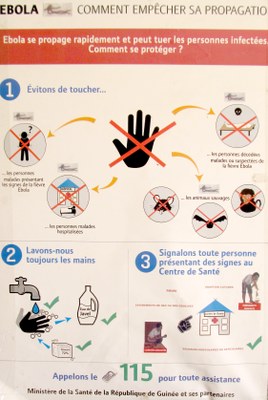 It is a day in November and I’m sitting in my office planning some upcoming activities with one of the senior staff of the Ministry of Health (MOH), Office of Strategy and Development, in Conakry, Guinea. Our work is interrupted when he gets a phone call. From our conversation afterwards, this is what I learned had happened:
It is a day in November and I’m sitting in my office planning some upcoming activities with one of the senior staff of the Ministry of Health (MOH), Office of Strategy and Development, in Conakry, Guinea. Our work is interrupted when he gets a phone call. From our conversation afterwards, this is what I learned had happened:
A woman from the interior of the country was suffering from a great deal of pain in her mouth. She did not feel she could get it handled where she lived so she travelled to Conakry. The call that morning was from a health worker because the woman in question had just died and the diagnosis was Ebola. Suddenly, the work we were doing, the discussion we were having, didn’t seem very important any more. It was a very strange, unsettling feeling sitting there, trying to comprehend what had happened. When working in difficult areas, I think you tend to put distance between yourself and whatever “unpleasantness” may be going on in the environment around you. The unpleasant issue may even be the very reason you are there—as in my case, I’m embedded in the Guinea MOH to try to help strengthen the weaknesses of the health information system that became all too apparent during the epidemic. But, somehow, you can almost pretend that it isn’t happening and just try to go about your work.
In my office, listening and trying to understand, this distance disappeared and I got a small look into what has been reality for too many people, in Guinea and elsewhere, since the epidemic began. The feeling I had with that brief look into another reality is one I don’t think I will be able to forget.
The health worker was calling the Ministry to make sure that they were following proper procedures for transporting the body and handling the burial arrangements. The procedure is this: the Red Cross staff, in complete isolation outfits, handle and prepare the body and ensure it is completely sealed up. Once the body is isolated from any possibility of contact, it is released to the family for burial. In earlier days, it was the Red Cross itself that would attend to the burial; but, with complete isolation of the body and surveillance of the burial process, families are now able to participate once again in the burial of their loved ones. From both a cultural and religious point of view, this is much more acceptable to the bereaved families.
Hearing these details about how the body is prepared, how it is sealed so it cannot be touched, I couldn’t stop images from flooding over me.
After a few minutes and a change of subject, my colleague and I went back to discussing an upcoming meeting. But we were really just going through the motions; head and heart would catch up later.
Post #5: The Price Some Pay for All
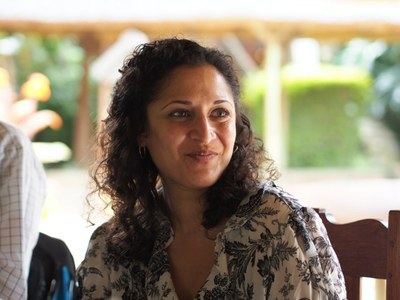 I am not the most appropriate person to write about the tragedy that is Anita Datar’s passing. I only knew her through the eyes of others, her Palladium family, others at MEASURE Evaluation who had seen or worked with her in the field. The testimonies and remembrances coming in remind us all that the light we all work for, and hopefully work within, just grew a little dimmer. Why Anita? There is no sense when this happens. She was a committed international development worker, trying to make a difference, trying to make the world a little better. We felt Anita as we read the announcement or heard the news. She represented us as she worked, just like we hopefully represent her when we work.
I am not the most appropriate person to write about the tragedy that is Anita Datar’s passing. I only knew her through the eyes of others, her Palladium family, others at MEASURE Evaluation who had seen or worked with her in the field. The testimonies and remembrances coming in remind us all that the light we all work for, and hopefully work within, just grew a little dimmer. Why Anita? There is no sense when this happens. She was a committed international development worker, trying to make a difference, trying to make the world a little better. We felt Anita as we read the announcement or heard the news. She represented us as she worked, just like we hopefully represent her when we work.
How do people like Anita, people like us, keep doing the work we do? There is probably not a single person who has been working for more than five years in an international development organization who has not experienced loss, at some level, related to the work we do. Tropical diseases, vehicle accidents, civil unrest, homicides—many of these all part of our life experiences. Some people experience these events and are lucky enough to come out on the other side. The ones that don’t, like Anita, pay the price so the rest of us can keep trying.
My history is probably “average”—truck accident in Zaire as a Peace Corps volunteer, acute malaria in Guinea, caught by an angry mob in Kathmandu following the massacre of the royal family, emergency landing of a Sabena flight due to a bomb threat, working in Afghanistan in early 2002.
Most recently, for the past two and a half months, I have been working in Guinea, Conakry. What is really the risk in working here? How does it compare to working other places or even crossing the street in your hometown? There are people who estimate such things. I think most people are OK with not knowing. I think we do what we do in most cases because it fulfills some need we have. Yes, we may know of the risks, or others may make us aware of them, but ultimately most of us don’t make decisions because of the risk that something untoward might happen.
I knew there were still new cases of Ebola being reported in Guinea. In fact, most of them end up in the capital city where I’m staying. Is there a chance of contracting Ebola while I am here? Most of life is comprised of non-zero probabilities. Does one (can one?) go around expecting something bad to happen? I like to think that most people are optimists by nature. Certainly I think that’s the case for the great majority of international development workers. Or at least I hope it is.
Personalizing the earlier question—how do I keep on doing the work I do, in this case working in an Ebola affected area? I believe in the work, I believe that we (the human race) can and must do better and I believe that at some level, I can contribute to this. In order to possibly contribute to making positive changes, I am willing to accept conditions that present unusual and sometimes elevated levels of risk. Do I or others working in this field really, on some level, reconcile ourselves to the idea that we have a real chance of dying in our line of work? Probably not, truthfully. We all probably think we will be the exceptions. But, if it does happen to one of us, can we say that we were willing to pay the price so that others can continue trying to make a difference? I hope so. I think it’s what Anita would say.
Post #6: What Has Data Got to Do with Ebola?
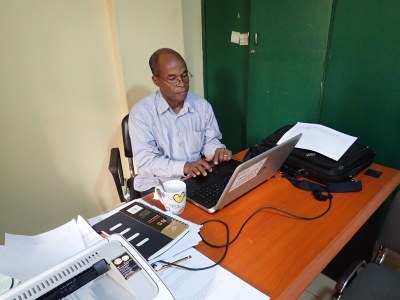 Guinea’s health information system has been “broken,” dysfunctional, or even non-functional for many years, probably since independence in 1958. There are many reasons for this, but the current status is that although data are collected at health facilities (i.e., health centers up to national hospitals), much of the data are not transferred to higher levels to be compiled, analyzed, reported on, and used. There are several reasons for this, mostly due to challenges of connectivity, transportation, lack of technology, and lack of resources generally.
Guinea’s health information system has been “broken,” dysfunctional, or even non-functional for many years, probably since independence in 1958. There are many reasons for this, but the current status is that although data are collected at health facilities (i.e., health centers up to national hospitals), much of the data are not transferred to higher levels to be compiled, analyzed, reported on, and used. There are several reasons for this, mostly due to challenges of connectivity, transportation, lack of technology, and lack of resources generally.
Given the problems in moving the data from the recording facilities to the next highest administrative level for processing, the Ministry either has to send teams down to the facilities to collect the data or they have to be content to wait months or longer for past data to finally be transmitted. Neither is ideal. And neither is adequate to observe and provide warning of an outbreak such as the Ebola epidemic.
Further limiting Guinea’s situation relative to health surveillance and the ability to act on information, the country is one of only two in the West Africa region that has not implemented the DHIS 2 software platform for compiling health data, either at a partial or a complete national scale. This has several implications in terms of the ability for Guinea to easily exchange data and draw upon regional experiences and support. It serves to “isolate” Guinea from the rest of the countries in the region, which exacerbates an already existing situation in which Guinea is often isolated internationally, as it typically receives less donor interest and funding than other countries in the region.
This also results in the situation that different national health programs (e.g., HIV and AIDS, malaria, tuberculosis, maternal/child health) often set up their own data recording, retrieval, analysis and reporting systems, parallel to the national health information system (HIS), which should be collecting and interpreting most of these same data. This is inefficient in terms of human resources and cost. It can also mean multiple reporting of the same data. Luckily, Guinea has taken the decision to implement the DHIS 2 platform going forward. I’ll write about that next.
Post #7: DHIS 2 to the Rescue
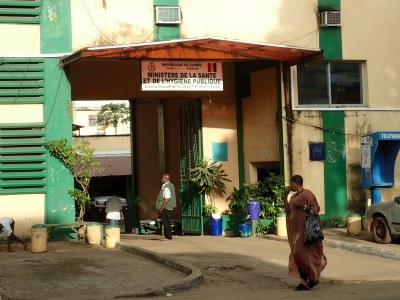 The severity of the Ebola epidemic has accelerated the search for appropriate digital platforms, including electronic and mobile data systems, and the potential of information and communication technologies (ICTs) to contribute to the restoration and long-term resilience of health systems. And those health systems in the Ebola-affected region of West Africa are getting a lot of attention.
The severity of the Ebola epidemic has accelerated the search for appropriate digital platforms, including electronic and mobile data systems, and the potential of information and communication technologies (ICTs) to contribute to the restoration and long-term resilience of health systems. And those health systems in the Ebola-affected region of West Africa are getting a lot of attention.
In order to accelerate country-led efforts to upgrade and strengthen Guinea’s health information system (HIS), USAID’s Global Development Lab (GDL), on behalf of the Guinea Ministry of Health (MOH), requested assistance in the form of embedded experts who can provide dedicated technical and organizational support to the health management information system (HMIS) unit located within the Directorate of Strategies and Development (“BSD” in French). That’s why I’m currently living in Conakry.
Most countries in West Africa —and in many parts of the developing world—use a data collection/analysis software platform called DHIS 2. DHIS 2 is a health management information system used in about 30 countries and a growing number of organizations across four continents. It helps governments and health organizations to manage their operations more effectively, monitor processes, and improve communication.
There are a number of advantages to Guinea if they join their neighbors in adopting DHIS 2. These include access to valuable training opportunities provided by the University of Oslo and its partners, cost-free access to software updates and technical assistance that come with the DHIS 2 system package, and opportunities for participating in south-to-south technical assistance through membership in the growing community of DHIS 2 users in the West Africa region.
As part of MEASURE Evaluation’s embedded team we’re helping move Guinea toward full implementation of DHIS 2, which we expect to produce a number of positive results:
- Efforts can be focused on local production and use of data (health centers, possibly health posts, and district hospitals) with data being entered into DHIS 2 at the district level.
- This will allow immediate analysis, action if necessary, and feedback to the health facilities where the data were collected.
- It also will make the data available at the regional level, so each region immediately has compiled, analyzed, and reported data across their region, to which they can add the additional data from the regional hospital.
- This means the region can analyze and make decisions on policy and allocating resources that are appropriate to conditions in their region.
- The final piece is that all of this data from every district and region across the country are available on the DHIS 2 web-based platform.
- The national level adds in the national reference hospitals and then has the complete picture of the routine health information situation for the entire country, available at any time.
This situation would allow health officials at the national level to make the kinds of decisions a health system must make, as well as allow them to provide any type of analysis and report that is needed or required, by the government or by donors. And, it would enable the country to see early on, in time to act effectively and efficiently, the emergence of a health threat such as Ebola.
Post #8: Feeling Optimistic
 The process for Guinea to get to the point where it can foresee emerging health issues and respond proactively is going to take some time. I’ve been here for the beginning part of this journey (ending this month) and have been updating this log of activities undertaken.
The process for Guinea to get to the point where it can foresee emerging health issues and respond proactively is going to take some time. I’ve been here for the beginning part of this journey (ending this month) and have been updating this log of activities undertaken.
Maybe a word here about organization development. We can put in all the software platforms we want; we can provide a help desk for software issues; we can update the software and train its users. But, if there is not a clear, common vision for this connected and data-enabled future, and if an environment is not created where personnel are fully and enthusiastically engaged, our efforts will not “stick” and a future epidemic may again catch the country unaware.
The world, the Guinean government, the Guinean Ministry of Health (MOH) and its staff, are committed to making the necessary changes. My work is in the role of a “coach,” to help: create a common vision for the MOH, analyze stakeholder interest and concerns, ensure effective and efficient communications among stakeholders (and there are many, see my blog #2), and foster and strengthen teamwork among the staff. We’re making progress on this, with several accomplishments in Month 1:
What we did:
- We drafted a three-month work plan that specifies planned activities, expected outputs and outcomes, and the proposed roles and responsibilities across our USAID collaborating partners.
- We established the National HIS Technical Group, led by the Directorate of Strategies and Development (“BSD” in French).
- We mapped health information systems (HIS) in use and advocated for MOH’s leadership role in the national health information system and also for the use of the DHIS 2 software platform.
- We began a registry of health facilities, as currently there is no complete, country-wide, unique, coded health facility registry.
- We are developing a costing plan for infrastructure, training, and personnel.
- We’re in the process of discussing mission and values going forward for the MOH.
As we achieve these outcomes, we also note for the record that there are obstacles we must all work through. There are new Ebola cases still coming in, though few; the MOH doesn’t have enough staff; often partners make last-minute requests, which makes it hard to plan work; the principle of having the MOH/BSD coordinate HIS activities is generally accepted but continues to move slowly in transition from the Office of the President.
And so, the work remains important. And always interesting.
Post #9: Countdown to Zero
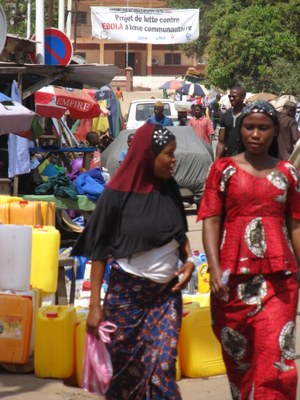 Finally, a light...
Finally, a light...
Barely a couple of weeks after a personal low in this series of blogs—“Post #4: Special (but sad) edition of Ebola Diaries”—came this wonderful high: “On the date of November 16, 2015, the last confirmed case, after two negative PCR tests, two days apart, has left the Ebola treatment center in Nongo, Conakry (translated from a Ministry of Health press release).”
Finally, the day that so many in this country, both residents and foreign workers, have been working to achieve—21 months and 18 days after the Ebola epidemic was first announced—finally the country can start the 42-day clock to Ebola-free status.
The news has been broadcast on local and international television and many people I talked to immediately after I found out, were already aware, although some were not. Maybe I wasn’t in the right place at the right time, or maybe celebration was muted, given the known “relapses” that occurred in both Liberia and Sierra Leone after the “first end” of the epidemic in those countries. But for whatever reason, it seemed like more of a big deal should have been made of the event.
As I started to think about it some more, I tried to imagine the roller coaster of emotions for those who have been involved, some since Day 1. How much longer would it last? How many more lives would have to be lost? Would it spread to even more areas before it could be brought under control? What would be the lasting impact of this epidemic, both nationally and internationally? Maybe the overriding emotion that you have when you finally reach something that you have been striving for, something that is literally a question of life and death, is simply relief.
And a prayer that this holds, that this really was the last Ebola case of this epidemic. Will there be other tests for these people in the future? Assuredly. Will Guinea be better prepared to respond to such challenges? It is our hope and our belief that it will.
Ultimately, for whatever role any of us working in Guinea during this period have played—however big or small the MEASURE Evaluation contribution to this effort has been—we all were working toward the same objective. And we did bring about positive change.
Finally, then, relief.
Post #10: Reflections
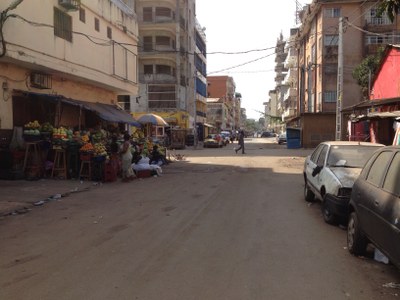 That things happen is a fact – a country is stricken by an Ebola epidemic, that’s a fact. But what’s the reality? For better or worse, there is no “one” reality. Things happen to each of us, but even when many people experience the same fact or event, the way each individual interprets that event is what determines reality for them. This is not always an easy concept to understand or accept.
That things happen is a fact – a country is stricken by an Ebola epidemic, that’s a fact. But what’s the reality? For better or worse, there is no “one” reality. Things happen to each of us, but even when many people experience the same fact or event, the way each individual interprets that event is what determines reality for them. This is not always an easy concept to understand or accept.
By the time I leave Guinea next week, I will have been working inside the Ministry of Health and alongside Guinean colleagues for three months. I have experienced many events—a mold-filled office without tables or chairs that would, after some modifications, become my office; colleagues who have family and social ties and expectations that regularly take priority over the 9-to-5 work; shortages of commodities important for basic operations (running water in bathrooms, electricity when power is cut); low daily wages for many people that have to be supplemented in order to make ends meet; civil unrest and even, unfortunately, deaths as a society goes to the polls. There are many other defining events I could list, but let me skip to the one that brought me here—an outbreak of a relatively mysterious, contagious, and deadly virus heretofore unknown/unrecognized in West Africa.
Working in the Ministry of Health, specifically for the Bureau of Strategy and Development, HIS Unit, what was my “reality” during my time here? Well, there were very few “absolutes,” for every rule that one tried to identify, there was immediately an exception. Actually so many exceptions to any particular perception or experience that I did not come away with any rules. I think I was lucky in my time here. There is a new spirit, a new enthusiasm in the particular office that I worked with. In times past, from what I am told, you could come into the area of the building where I have been working and find almost nobody in their office. It wasn’t that they were necessarily in the field, it was either that staff had not been hired or the staff that were supposed to be here were not because there was nothing being done. These days, new staff have been hired, some seconded from multilateral agencies to help reconstruct, some “grey beards” like myself who had worked for the Ministry in years past, during the golden years of the Primary Health Care/Bamako Initiative activities.
I guess what I want to say is that there are good national staff trying to make things happen. Not everybody is on board because, for many who have not had mentors or positive experiences working in the public sector over the years, there are negative behaviors and practices already established. Some staff recognize this and are willing and able to change. Some are not. Life is generally not easy in Guinea, and the majority of the local environment does not make positive change easy to bring about.
But…I have seen good, positive things happen in my two-plus months. There is more consideration of fellow colleagues, better respect of working norms, meetings more regularly scheduled and better organized, partners beginning to trust and count on government counterparts. People are talking about the future in positive terms, there are expectations that things will continue to move forward.
Ultimately, as I get ready to leave after my three months here, I remember some of my parting feelings after working and living here for three years, 1988–1991, on a CDC project. For all the challenges Guinea faces, there is a spirit that endures. People know that things should be better; they know things can be better. And they know that, despite setbacks that may occur, you never give up hoping for and trying to bring about the promise of a country that began so proudly more than a half century ago.
That is what will be my “reality” from the time here. It won’t happen tomorrow or the next day, but I know that someday in a not-too-distant future, Guinea will right itself and deliver on its promise. Good quality information (accurate, complete, and timely) used to make sound decisions is the road map to getting there. The Ministry of Health is starting to put that road map together. This is the end of these Ebola Diaries but the development story will continue. Thanks to all out there for fighting the good fight.












